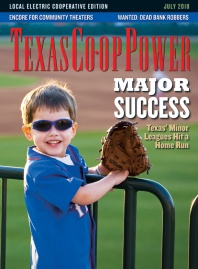Tesla: First Out of the Box?
I always look forward to receiving your interesting magazine that covers many different subjects. The May 2010 article “Plugging in, Hitting the Road” just might not be out-of-the-box thinking.
In 1931, Nikola Tesla took a gasoline engine from a new Pierce-Arrow automobile and replaced it with an 80-horsepower, 1,800-rpm electric motor. This electric vehicle was driven at speeds of up to 90 mph, and no charging was necessary. One week was spent testing the vehicle.
Tesla said his car was powered from the ethers all around us. If no charging were necessary, then there would be no need for batteries except for accessories, which could probably use the same energy source. Tesla said there was an unlimited amount of this energy and that it could also be used to power our homes.
A.C. Greene wrote about the test in his January 24, 1993, “Texas Sketches” column in the Dallas Morning News. Several newspapers in Buffalo, N.Y., also reported on the test.
Many people do not know about Nikola Tesla, yet they know about Thomas Edison for whom Tesla once worked. Edison designed a direct current electrical system, but Tesla developed the alternating current electrical supply system that is used today in our homes and factories. This is only one of many items and patents by Tesla, including the radio, that he was awarded at a later date.
Harold H. Taylor Jr., Grayson-Collin Electric Cooperative
Demise of Devils River?
The Devils River (re: “Not for the Faint of Heart: Devils River,” May 2010) used to be an unintentional secret due to its location and near inaccessibility. We discovered it 25 years ago when we found a man who owned a ranch [nearby], and for a nominal fee we enjoyed the river off and on several times a year.
The Houston Chronicle, Texas Parks and Wildlife magazine, Texas Highways magazine, et al, began running full-page and multipage stories about this pristine and extremely sensitive area. Now, on any fair weekend you will note a dozen or more canoes and kayaks floating past this ranch, all of them fishing and most camping on private property, eating their fish that they’ve caught. We used to catch AND RELEASE 3-, 4- and occasionally 5-pounders, but no more. One is lucky to catch five or six little bass per day and the smallmouth, which used to be so ubiquitous, are a rarity. In short, we don’t bother to go there anymore. … Your article was just among many that popularized the river and led to its demise. Congratulations.
Ray Wolbrecht, Kyle
Editor’s Note: We believe all Texans owe thanks to the landowners who have helped keep the Devils River—and other wild places in the state—in near-pristine condition. Recognizing that the vast majority of our readers are unlikely to undertake this trip themselves, we hope the article offers a glimpse of the experience. For those who do make the trip, we did our best to emphasize the need for extensive research and planning and hope that those drawn to the beauty of this— and all wild places—are moved to preserve and honor it, just as the many landowners on the Devils River have.
Saving Devils River
Thanks for your support and conservation efforts.
Kelly Lefkowitz, Dallas, Board member, The Friends of the Devils River, www.friendsofthedevilsriver.com
Enchanted Birthday
I enjoyed the article in the May 2010 issue about Enchanted Rock. On April 19, after spending the night alone in my tent in the quiet, dark campground, I was on the top of the rock at daybreak. It was my 73rd birthday, and I was the only climber on the rock that early morning. As I ate a piece of my birthday cake at the summit, it was a dream come true. It was the first time I had seen or climbed Enchanted Rock, although I had heard about it for years.
Barbara Hankins, Houston County Electric Cooperative
Editor’s Note: The Enchanted Rock story, “Rock of Ages,” did not appear in some cooperatives’ issues of the magazine.
Avoid Sexist Language
I have read your magazine with interest since moving to Canyon Lake three-plus years ago. I don’t recall reading a sexist piece in it before the May 2010 issue (“Co-op People” that describes the rescue of two Texas Army National Guard paratroopers stuck in trees). When I taught communication at several universities, one of the first things I stressed with my students was to stop using the language of discrimination.
You presented an interesting story until you got to the second paratrooper. All of the sudden, it was the 1950s again: “… a female paratrooper was clinging like a squirrel …” The first paratrooper was NOT identified by gender, so why was the second? You should either call both “paratrooper” or identify each by gender, “male paratrooper” and “female paratrooper.” Nothing cutesy was said about the male paratrooper who was “entangled in branches about 40 feet high. … he was in an awkward position, with one leg caught in a branch above his head…” If you’re going to compare the female paratrooper to a squirrel, perhaps you’d like to compare the male paratrooper to a crazed opossum. Or, perhaps, both should be shown dignity in their awkward and embarrassing predicaments.
Jackie De Hon, Pedernales Electric Cooperative
Preserving Aquarena Springs’ Heritage
Congratulations to writer Camille Wheeler and photographer Will van Overbeek on an excellent feature about Aquarena Springs (“Exploring the Depths,” April 2010). As a follow-up, we wanted your readers to know that while plans move forward on a new chapter for the springs, Texas State University is also working to preserve elements of the cultural heritage.
In a joint partnership effort between the Public History Program and the University Archives, students are conducting oral histories and collecting, cataloguing and interpreting artifacts and documents associated with the site. This unique approach to preserving the history of a major tourist attraction provides a diverse background for understanding its contributions to broader contexts of the recent past, including heritage tourism, environmental education and the travel industry. Readers who have connections to the Aquarena Springs story—employees, tourists, promoters, underwater archaeologists, etc.—are encouraged to help the students as they develop the Aquarena Springs Collection, which will be available for future students, outside researchers and others interested in the cultural history of the springs. To learn more about the oral history project, contact me at [email protected]; to inquire about donations of artifacts, photographs or papers, contact University Archivist Kris Toma at [email protected]. Thanks.
Dan K. Utley, Department of History,Texas State University, San Marcos
Searching For Agarita
In the March 2010 issue of Texas Co-op Power, you had a short article on the agarita plant. I have been trying to get information on where I may purchase it. None of the nurseries in my area have ever heard of it. Who can I contact for more info?
Betty Johanson, San Patricio Electric Cooperative
Editor’s Note: Agarita (Mahonia trifoliolata) is an evergreen shrub native to the area from coastal South Texas northwest to the Trans-Pecos region. Check the Lady Bird Johnson Wildflower Center website, www.wildflower.org, for more information.


